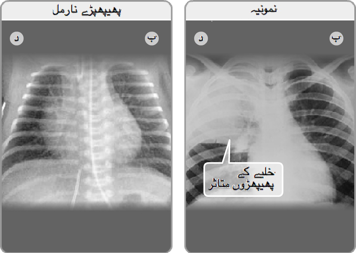نمونیا کیاہے؟
نمونیا، یا نظامِ تنفس کے ذیلی راستے میں انفیکشن ، اس اصطلاح کو پھیپھڑوں کے اندر انفیکشن کی وضاحت کے لئے استعمال کیا جاتا تھا۔ نمونیا کے زیادہ تر کیس وائرس کے سبب ہوتے ہں اور یہ نزلہ و زکام کی علامات کے بعدظاہرہو سکتے ہیں۔ بیکٹیریا کے سبب نمونیا کے کیسوں کی ٓتعداد کم ہوتی ہے۔
نمونیا کی نشانیاں اور علامات
بچوں میں نمونیا کی علامات مختلف ہوسکتی ہیں۔ وہ نزلہ وزکام یا نظامِ تنفس کے بالائی راستے کی علامات سے مماثلت رکھ سکتی ہیں۔ نمونیا کی عام نشانیاں اور علامات جن میں مندرجہ ذیل شامل ہیں:
- تیز بخار
- کھانسی
- سانس کا تیز تیز چلنا
- سانس لینے میں دشواری پیش آنا
- پھپہڑوں میں سے چٹخنےکی سی آوازیں آتی ہوں
- بھوک کا نہ لگنا
- کھانسی یا بلغم کو نگلنے کی وجہ سے قے ہونا
- عام طورپرتھکن سے چور اور ذہنی، جِسمانی اور جذباتی طور پر پریشانی محسوس ہونا
- معدہ(پیٹ)کادرد
آپ کا ڈاکٹر نمونیےکے لئےکیاکرسکتا ہے
اگر آپ کے ڈاکٹر کو نمونیا کا شبہ ہوتا ہے، تو ممکن ہے کہ آپ کے بچےکےسینےکاایکسرےہو۔ ایسا بھی ہو سکتا ہے کہ آپکے بچےکا ڈاکٹر کچھ خون کےٹیسٹ بھی کروائے۔ وائرس کے باعث ہونے والے نمونیے کاعلاج اینٹی بائیوٹک سے کرنےکی ضرورت نہیں، لیکن وائرل اور بیکٹیریئل کی الگ الگ وجوہات بتانا مشکل ہوسکتی ہیں۔ اُس کی بہترین طریقے سے دیکھ بھال کرنے سے پہلے آپ کے بچے کا ڈاکٹر بہت سے عوامل کو مدِنظر رکھے گا۔
ضرورت پڑنے پر ہسپتال میں داخلہ

ذیادہ تر بچوں کی نِگہداشت گھر پر ہوسکتی ہے۔ جو بچے زیادہ بیمار ہیں ممکن ہے کہ اُن کو ہسپتال میں داخل کرنے کی ضرورت پڑے۔ اس بات کا بھی امکان ہے کہ اُن کو آکسیجن اور دوسری ادویات دینے کی ضرورت پیش آئے۔ ایسا بھی ہو سکتا ہے کہ ابتداء میں بچے کو اس کی رگ میں( درون و ریدی طور پر ) اینٹی بائیوٹکس دی جائیں، اورغالباً بعد میں منہ کے ذریعے سے جیسے جیسے بچے کی طبیعت بہتری آتی ہے۔
اپنے بچے کی گھر پر نگہداشت
تمام اینٹی بائیوٹکس مکمل طور پرختم کریں
اگر آپ کے بچے کو اینٹی بائیوٹک کا نسخہ تجویز کر دیا گیا ہے، تو اُس کو ساری دوائیں تجویزکردہ نسخے کےحساب سے ضرور لینی چاہیں۔ اپنے بچے کو اینٹی بائیوٹک کے علاج کاپوراکورس لازماً مکمل کروائیں، اگرچہ وہ بہتر محسوس کر رہا ہو تب بھی۔ اس کو دوبارہ ہونے سے روکنے، مدافعت، اور دوسری پیچیدگیوں کے لئے یہ بہت اہم ہے ۔
بخار کا علاج اور نگرانی
بخار کے لئے اسیٹامائنوفین یعنی (ٹائلینول، ٹیمپرا، یا دیگر برانڈز)، یا آئیبیوپروفین (موٹرین، ایڈول، یا دیگر برانڈز) کا استعمال کریں۔ اپنے بچے کو اے ایس اے (اسی ٹائل سیلی سیلک ایسڈ یا ایسپرین) ہرگز نہ دیں۔
اپنے بچےکے جسم میں پانی کی مقدارکو برقرار رکھیں
جسم میں پانی کی مقدار کو برقرار رکھنے کے لئے اپنے بچےکو وافر مقدار میں مائعات پلائیں۔ آپ کے بچے کی بھوک کم ہو جانے کا بھی امکان ہے، لیکن اس میں بہتری آئے گی جب ان میں انفیکشن ٹھیک ہونا شروع ہو جائے گی اور وہ بہتر محسوس کرنے لگیں گے۔
شروع میں آپکے بچے کو زیادہ کھانے کی حاجت نہیں ھو گی۔ لیکن جونھی انفیکشن میں آفاقہ ھونا شروع ھو گا تو بچہ اپنے آپ کو بہتر محسوس کرنے لگے گا تو بتدریج اسکی بھوک بژھ جا ئے گی۔
دھوئیں والی جگہوں سے گریز کریں
اپنے بچےکو دھوئیں اور پھیپھڑوں میں سوزش یا خراش پیدا کرنے والی چیزوں سے دور رکھیں
کھانسی کی علامات
اس بات کا بھی امکان ہے کہ آپ کے بچے کی کھانسی صحیح ہونے سے پہلے شدیدترین ہو جائے۔ جیسے ہی نمونیا تحلیل ہوتا ہے، آپ کا بچہ بلغم سے چھٹکارا حاصل کرنے کے لئے کھانسے گا۔ ممکن ہے کہ اس کی کھانسی کچھ ہفتوں تک جاری رہے۔
طبی مدد کب حاصل کریں
اپنے بچہ کے معمول کے ڈاکٹر سے رابطہ کریں اگر:
- آپ کے بچےکی کھانسی تین ہفتے سے زیادہ عرصے تک جاری رہتی ہے
- اینٹی بائیوٹکس شروع کرنے کے بعد آپ کے بچے کا بخار 3 دن سے زیادہ عرصے تک رہتا ہے
اپنے بچے کو قریبی ایمرجینسی ڈیپارٹمینٹ میں لے جائیں، یا اگر ضروری ہو تو911 پر کال کریں، اگر آپ کے بچہ کو :
- سانس لینے میں دشواری حد سے زیادہ بڑھ رہی ہو
- بہت زرد پڑ جائے یا ہونٹ نیلے ہوجائیں
- اینٹی بائیوٹک خوراکوں کی قےکر رہا ہو یا پینے والی چیزیں پینے سے منع کر رہا ہو
- دیکھنے میں بہت بیمار نظر آرہا ہو
اہم نکات
- نمونیا پھیپھڑوں کی ایک انفیکشن ہے۔ وائرس یا کبھی کبھار بیکٹیریا اِس کا سبب بن سکتے ہیں۔
- اگر آپ کے بچےکو اینٹی بائیوٹکس کا نسخہ تجویز کیا جاتا ہے، تو اس بات کو یقینی بنائیں کہ وہ اینٹی بائیوٹکس کا پوراکورس مکمل کرتا ہے، اگرچہ کہ آپکا بچہ بہتر بھی محسوس کر رہا ہو
- بچے کو پُرسکون اور جسم میں پانی کی مقدار کو برقرار رکھیں
